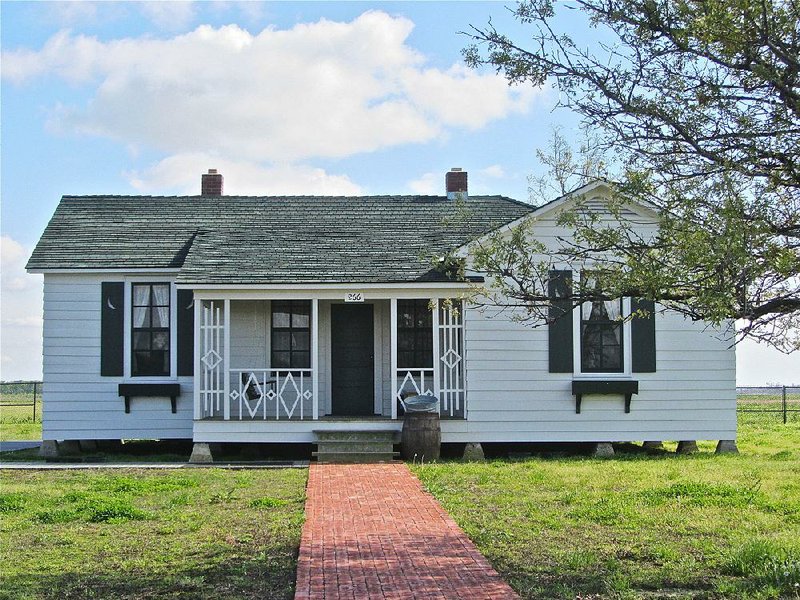The Arkansas Historic Preservation Program has nominated 14 properties for the National Register of Historic Places.
They include a Cold War military base, a poor farm cemetery and the boyhood home of Johnny Cash.
[360-DEGREE PHOTO: See inside Johnny Cash's boyhood home]
The program's State Review Board made the decision Wednesday, nominating all 14 properties that were proposed.
Mark Christ, a spokesman for the preservation program, said there's a good chance all 14 will be listed. The Arkansas program has a 98 percent success rate with its nominations because the sites go through a "rigorous internal determination of eligibility" before being nominated.
"The 14 properties that were nominated to the National Register really reflect the diversity of Arkansas' historic resources, ranging from a prehistoric site to midcentury buildings constructed in the 1960s," said Christ. "We anticipate that the National Park Service will add them to the National Register within the next two months."
The National Register of Historic Places is the official list of the nation's historic places worthy of preservation.
The Arkansas board meets three times a year and usually considers seven to 15 properties at each meeting.
One of the unique properties nominated Wednesday was the Blytheville Air Force Base Strategic Air Command Alert and Weapons Storage Areas.
Most of the facility was built about 1959 as part of a Cold War military base.
The name was changed in 1988 to Eaker Air Force Base. The base closed in 1992.
The high-security area included a parking apron and taxiway to access the runway.
Positioned around the apron are four main buildings, a control tower, a guard shack, nine small shelters, a basketball court, a swimming pool, and a security fence and gate. A road surrounds the "alert area" just inside the security fence.
The Alert Crew Readiness Building is a two-story, reinforced-concrete structure "designed to provide protection in the event of nuclear attack," according to the nomination form. Known as the "mole hole," it has an earthen berm that extends to the second floor.
The concrete apron, which is often referred to as the chevron or Christmas tree, contains nine separate aircraft parking branches, each of which is capable of accommodating one B-52 bomber or refueling tanker aircraft, according to the nomination.
The Strategic Air Command's alert program "was able and ready to provide a counterattack within 15 minutes in the event of a Soviet initiated strike on the United States," according to the nomination.
Another unique nominee is Elmwood Cemetery in Fort Smith, which includes graves dating to 1891 and associated with Sebastian County's poor farm, an institution for paupers.
According to the nomination form, the cemetery contains more than 800 graves but has markers for only seven of them.
The remains of 70 people were moved to Oak Cemetery when a drainage ditch was installed through part of Elmwood Cemetery around 1990, according to the nomination.
"The poor farm system was an important part of the social fabric in several Arkansas counties during the late 19th and early 20th centuries," according to the nomination. "As with most of the poor farms in Arkansas, the cemetery at the Sebastian County poor farm is the last surviving vestige of the farm."
Similar poor farm cemeteries in Benton, Carroll, Cleburne and Clay counties are already listed on the National Register.
The 1934 Johnny Cash Boyhood Home in Dyess is administered by Arkansas State University, which restored it in 2014.
Besides its significance as Cash's boyhood home, the building is a good example of a New Deal-era colony house, according to the nomination.
The one-story, five-room farmhouse was built by the Federal Emergency Relief Administration using standard plans designed by Arkansas architect Howard Eichenbaum.
The Cash family sold the farm in 1954.
Other properties nominated Wednesday are:
• The Arkansas Teachers Association Headquarters Building and the Professional Services Building in Little Rock, finished in 1965. These are separate buildings.
• The College Avenue Historic District in Conway, featuring buildings constructed between 1910 and 1950.
• The Greenwood School at Hot Springs, a 1930 art deco building.
• The 1962 Robert Wanslow House in Fort Smith.
• Fitzgerald Historic District in Fort Smith, featuring buildings constructed between 1905 and the 1940s.
• The R.L. Leach Grocery Store at Dutch Mills in Washington County, built around 1925.
• The Highfill Community Building in Highfill, built in 1911.
• The Grand Army of the Republic Monument in Gentry, installed in 1918 to honor Union Civil War veterans.
• The Green Valley Homestead at Sturkie in Fulton County, a complex of log buildings constructed between 1936 and 1943.
• Sherman Mound and Village in Mississippi County, an archaeological site with evidence of activity between 1200 and 1650 A.D.
The board also listed several properties on the Arkansas Register of Historic Places, which recognizes historically significant properties that do not meet National Register requirements. They include Edwards Chapel at Russellville, Lafayette School Gymnasium at Camden, Lake June at Stamps and Captain Daniel Matthews House at Osceola..
Metro on 12/08/2017
